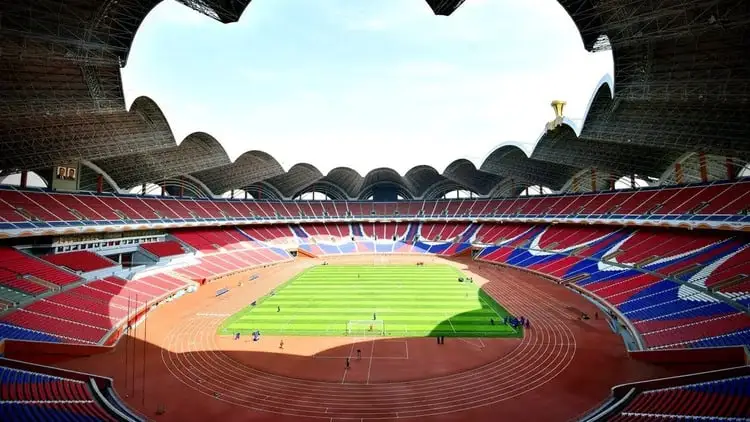Stadiums are more than just venues for sports; they are symbols of pride, culture, and history. Capable of hosting thousands of spectators, they create unforgettable experiences and highlight the pinnacle of human achievement in sports and entertainment.
This article ranks the world’s 10 largest stadiums by seating capacity, highlighting their major events, main sports, and the famous teams that call them home.
10. Bryant–Denny Stadium – 100,077 capacity
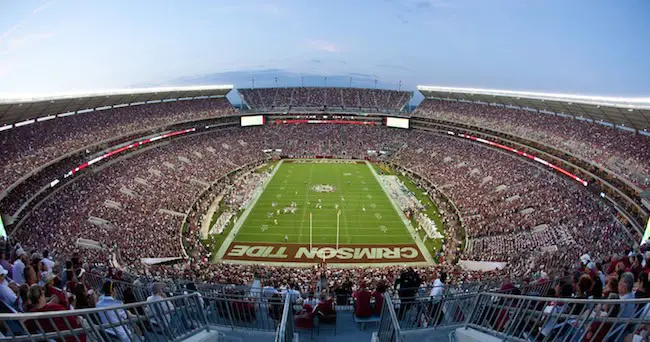
Bryant–Denny Stadium, located in Tuscaloosa, Alabama, is the iconic home of the University of Alabama Crimson Tide football team, one of the most successful programs in college football history.
First opened in 1929, the stadium has undergone numerous expansions and renovations, reaching a current capacity of 100,077 in 2010.
This makes it the 10th-largest stadium in the world and the 5th largest in the United States.
The stadium is the heart of Crimson Tide tradition, hosting legendary games and championship-winning seasons.
It is the stage for the Iron Bowl, the heated annual rivalry game between Alabama and Auburn University, considered one of the greatest rivalries in American sports.
Bryant–Denny has also been the backdrop for 12 national championship seasons, defining the dominance of Alabama football under iconic coaches like Paul “Bear” Bryant and Nick Saban.
Over the decades, countless football legends have showcased their talent on this field, including Joe Namath, Derrick Henry, and Tua Tagovailoa, further cementing the stadium’s reputation as a Centre spot of college football.
9. Darrell K Royal–Texas Memorial Stadium – 100,119 capacity
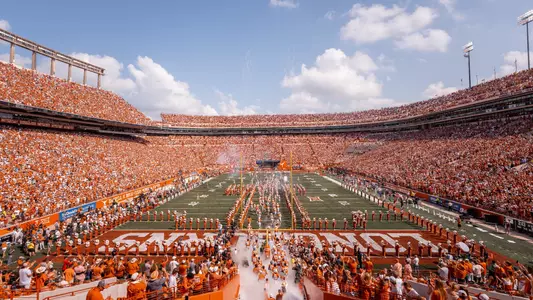
Darrell K Royal–Texas Memorial Stadium, located in Austin, Texas, is the historic home of the University of Texas Longhorns football team, one of the most storied programs in college football.
Opened in 1924, the stadium was later renamed in honor of Darrell K Royal, one of the winningest coaches in American football. With a seating capacity of 100,119, it stands as the 9th largest stadium in the world and the 4th largest in the United States.
The stadium has been the stage for countless legendary moments, none greater than the 2006 Rose Bowl, where the Texas Longhorns, led by quarterback Vince Young, defeated USC in one of the greatest games in college football history, securing the national championship.
Beyond that, Darrell K Royal–Texas Memorial Stadium has witnessed the brilliance of celebrated coaches like Mack Brown and Tom Herman, as well as Heisman Trophy winners and standout players, including Earl Campbell, Ricky Williams, and Colt McCoy.
More than just a venue, the stadium represents the pride and tradition of Texas Longhorns football, serving as both a fortress for unforgettable victories and a landmark in the culture of American college sports.
8. Neyland Stadium – 101,915 capacity
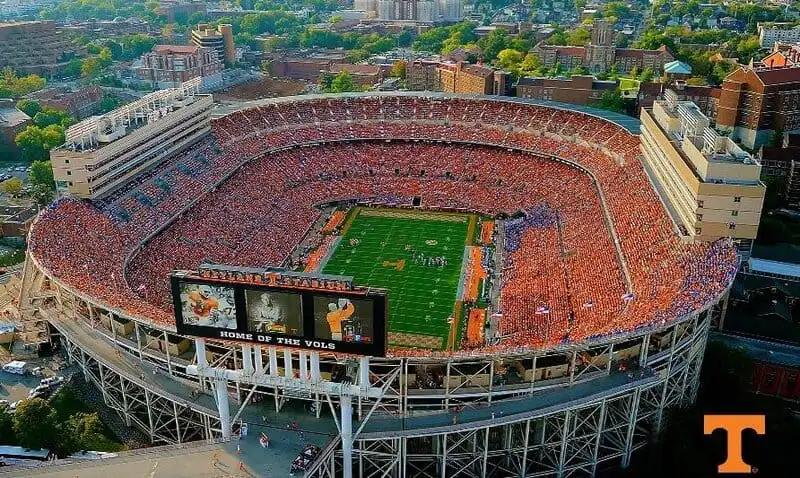
Neyland Stadium, located in Knoxville, Tennessee, United States, is the home of the University of Tennessee Volunteers football team, one of college football’s most storied and tradition-rich programs. Opened in 1921, the stadium is named after Robert Neyland, the longest-serving and most successful coach in Tennessee history.
With a current seating capacity of 101,915 since 2022, it ranks as the eighth largest stadium in the world and the third largest in the United States.
This Stadium was opened in 1921 as Shields-Watkins Field with a single grandstand for 3,200 fans. Through 16 major expansions, it has grown into a massive venue.
Key expansions included enclosing the south endzone in 1948, adding upper decks in the 1970s, and finally forming its signature bowl shape in 1980. A 1996 expansion peaked its capacity at over 104,000 and ADA compliance brought it to its current size.
Neyland Stadium has hosted many historic games, including the 1998 Fiesta Bowl, where the Volunteers won the national championship, led by quarterback Tee Martin.
7. Tiger Stadium – 102,321 capacity
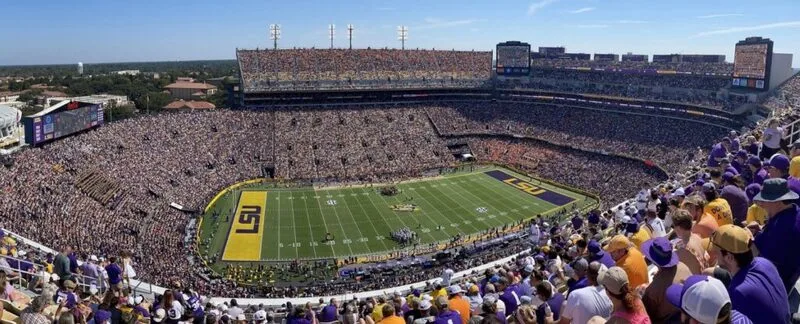
Tiger Stadium is located in Baton Rouge, Louisiana, United States. It is the home stadium of the Louisiana State University Tigers football team, one of the most dominant and successful programs in college football. The stadium was opened in 1924 and is nicknamed “Death Valley” for its intimidating atmosphere and loud noise.
The stadium has a capacity of 102,321, making it the seventh largest stadium in the world, and the second largest in the United States.
Tiger Stadium has hosted many classic games and events, such as the 2003 BCS National Championship Game, where LSU defeated Oklahoma to win the national title, led by coach Nick Saban and quarterback Matt Mauck. The stadium has also seen the glory of coaches like Les Miles and Ed Orgeron, and players like Joe Burrow, Leonard Fournette, and Tyrann Mathieu.
6. Kyle Field – 102,733 capacity
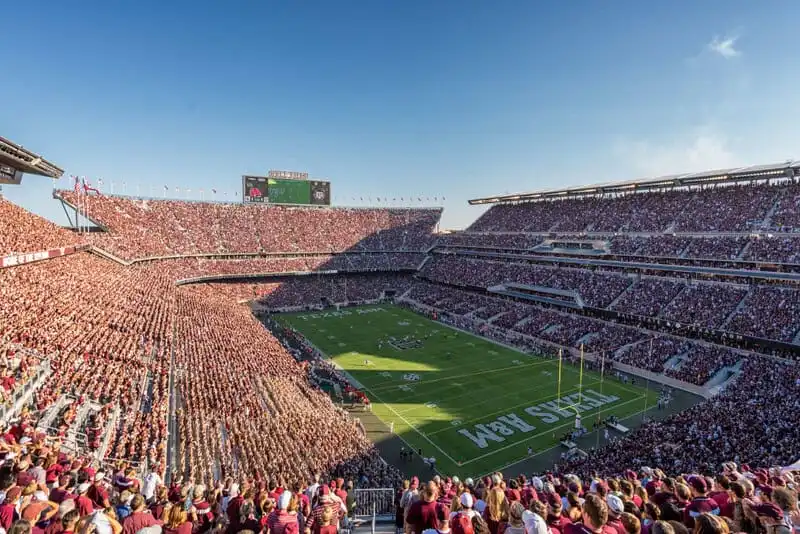
Kyle Field is located in College Station, Texas, United States. It is the home stadium of the Texas A&M University Aggies football team, one of the most passionate and loyal fan bases in college football.
The stadium was opened in 1904 and is named after Edwin Jackson Kyle, a former professor and dean of agriculture at the school.
Kyle Field has hosted many remarkable games and events, such as the 1999 Bonfire Game, where Texas A&M defeated Texas in an emotional tribute to the 12 students who died in a bonfire collapse. The stadium has also experienced the greatness of coaches like R.C. Slocum and Jimbo Fisher, and players like Johnny Manziel, Von Miller, and Myles Garrett.
5. Ohio Stadium – 102,780 capacity
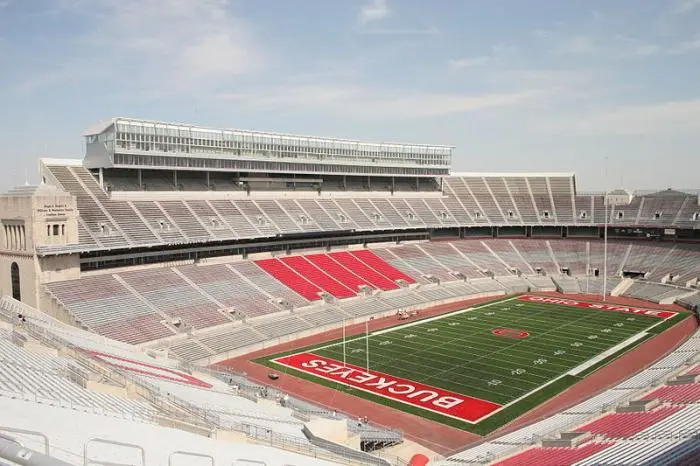
Ohio Stadium, located in Columbus, Ohio, United States, is the home stadium of the Ohio State University Buckeyes football team, one of the premier and most successful programs in college football. Opened in 1922, the stadium is nicknamed “The Horseshoe” for its distinctive horseshoe-shaped design.
Ohio Stadium was built with a capacity of 66,210. A series of expansions and renovations grew it to over 100,000 seats by 2001, with the final major renovation in 2014 reaching its current capacity.
The stadium has hosted record crowds surpassing its official capacity, with the largest attendance recorded at 110,045 during the 2016 game against Michigan.
Ohio Stadium has been the site of many historic games and events, including the 2003 Fiesta Bowl, where the Buckeyes defeated Miami in double overtime to win the national championship under coach Jim Tressel and quarterback Craig Krenzel. The stadium has also witnessed the success of legendary coaches such as Woody Hayes and Urban Meyer, and celebrated players like Archie Griffin, Eddie George, and Ezekiel Elliott.
Besides football, Ohio Stadium has hosted track and field events, concerts by major artists, and served as the venue for university commencement ceremonies.
4. Beaver Stadium – 106,572 capacity
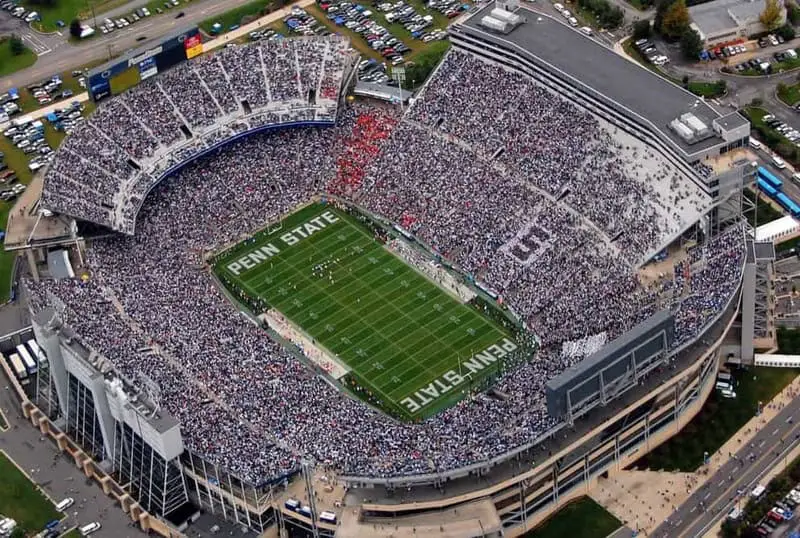
Beaver Stadium, located in State College, Pennsylvania, United States, is the home of the Pennsylvania State University (Penn State) Nittany Lions football team, known for its consistent competitiveness in college football. Opened in 1960, it is named after James A. Beaver, a former governor of Pennsylvania and president of the university’s Board of Trustees.
The stadium has undergone six major expansions since its opening. Initially built with a capacity of 46,284, expansions in 1969, 1972, and 1976 progressively increased seating.
A unique 1978 renovation involved lifting the existing structure to insert new seating, raising capacity to 76,639. Further expansions in the 1980s and early 2000s brought the stadium to its current size.
In 2011, capacity was slightly reduced to comply with the Americans with Disabilities Act. Beaver Stadium holds a record attendance exceeding 111,000 spectators.
Beaver Stadium has hosted numerous memorable games, including the 1987 Fiesta Bowl, where Penn State defeated Miami to win the national championship under coach Joe Paterno and running back D.J. Dozier. Notable figures associated with the stadium include coaches Bill O’Brien and James Franklin, as well as prominent players such as Saquon Barkley, Trace McSorley, and Micah Parsons. The stadium is a central hub of Penn State’s football tradition and a significant part of college football history.
3. Michigan Stadium – 107,601 capacity
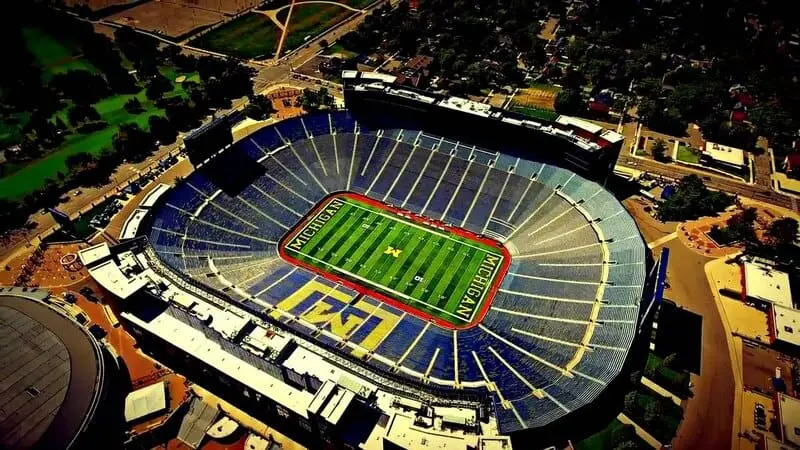
Michigan Stadium, located in Ann Arbor, Michigan, United States, is the home of the University of Michigan Wolverines football team, a historic and successful college football program.
Opened in 1927, it is famously nicknamed “The Big House” due to its massive size and seating capacity. The stadium officially seats 107,601, making it the largest stadium in the United States and the third-largest worldwide.
It has hosted record crowds exceeding 115,000, with the highest attendance of 115,109 occurring during a game against Notre Dame in 2013.
The stadium has undergone several expansions and renovations, starting with an initial capacity of 72,000.
Over the decades, permanent steel bleachers and a press box were added, gradually increasing seating.
Michigan Stadium was the first in the U.S. to install electronic scoreboards in 1930.
The most recent major renovation between 2007 and 2010 added premium amenities and raised capacity closer to 110,000.
Michigan Stadium has been the site of many iconic events, including the 1997 Rose Bowl, where the Wolverines won the national championship under coach Lloyd Carr, led by Heisman Trophy winner Charles Woodson.
It has also been home to legendary coaches and players such as Bo Schembechler, Jim Harbaugh, Tom Brady, Desmond Howard, and Denard Robinson, cementing its status as a symbol of American college football tradition and excellence. The stadium also hosts non-football events such as NHL games and soccer matches.
2. Rungrado 1st of May Stadium – 114,000 capacity

The Rungrado 1st of May Stadium, located on Rungrado Islet in Pyongyang, North Korea, is the second-largest stadium in the world by capacity.
Opened on May 1, 1989, it spans over 207,000 square meters (51 acres) and features a seating capacity officially reported as 150,000, although seating counts following a 2014 renovation estimate the capacity closer to 114,000.
The stadium’s unique design includes a scalloped roof with 16 arches arranged in a ring resembling a magnolia blossom, North Korea’s national flower, with roof peaks reaching 60 meters above ground.
Primarily used for football and athletics, the Rungrado Stadium is most famous for hosting the Arirang Festival, which is an enormous mass gymnastics and artistic event celebrating North Korean culture and ideology, recognized by Guinness World Records as the largest choreographed mass performance.
The stadium has also been the venue of significant international events, such as the 1995 World Festival of Youth and Students and the 2018 Inter-Korean Summit, underscoring its cultural and political importance.
Boasting 80 entrances to facilitate rapid crowd movement, including a dedicated VIP entry for North Korean leaders and foreign dignitaries, Rungrado 1st of May Stadium remains an iconic global sports and political venue.
1. Narendra Modi Stadium – 132,000 capacity
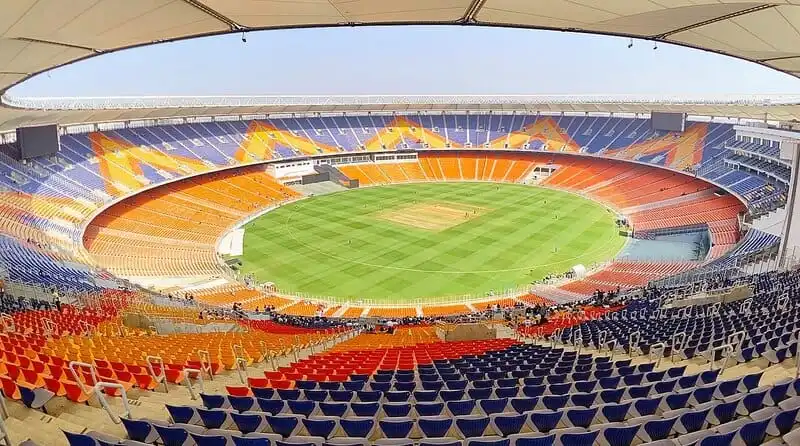
Narendra Modi Stadium, located in Ahmedabad, Gujarat, India, is the world’s largest stadium by capacity and the largest cricket stadium.
Opened in 2020, it is named after Narendra Modi, the Prime Minister of India and former Chief Minister of Gujarat. The stadium spans over 63 acres and can accommodate 132,000 spectators.
Dedicated exclusively to cricket, the most popular sport in India, Narendra Modi Stadium has hosted significant matches including the 2011 Cricket World Cup quarter-final, the 2016 ICC World Twenty20 semi-final, the 2021 India-England pink-ball Test match and many other league matches.
It has witnessed performances by some of best Indian athletes and cricket’s greatest players, such as Sachin Tendulkar, Virat Kohli, and Jasprit Bumrah.
As of 2025, the top 10 largest stadiums in the world stand not only as monumental feats of architecture but also as cultural and historical landmarks.
With seating capacities exceeding 100,000 spectators, these stadiums have hosted some of the most iconic and thrilling moments in sports history, inspiring millions of fans and athletes across the globe.
They are revered as temples of sport, celebrated for their rich legacies, electrifying atmospheres, and enduring impact on the global sporting landscape, reflecting diverse sporting cultures and traditions worldwide.
